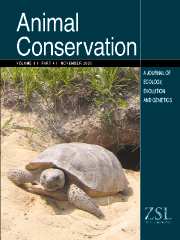Crossref Citations
This article has been cited by the following publications. This list is generated based on data provided by
Crossref.
Fuller, Trevon
Munguía, Mariana
Mayfield, Michael
Sánchez-Cordero, Víctor
and
Sarkar, Sahotra
2006.
Incorporating connectivity into conservation planning: A multi-criteria case study from central Mexico.
Biological Conservation,
Vol. 133,
Issue. 2,
p.
131.
Sarkar, Sahotra
Pressey, Robert L.
Faith, Daniel P.
Margules, Christopher R.
Fuller, Trevon
Stoms, David M.
Moffett, Alexander
Wilson, Kerrie A.
Williams, Kristen J.
Williams, Paul H.
and
Andelman, Sandy
2006.
Biodiversity Conservation Planning Tools: Present Status and Challenges for the Future.
Annual Review of Environment and Resources,
Vol. 31,
Issue. 1,
p.
123.
Chen, You-Hua
2007.
Prioritizing Avian Conservation Areas in China by Hotspot Scoring, Heuristics and Optimisation.
Acta Ornithologica,
Vol. 42,
Issue. 2,
p.
119.
Gaytán, Roberto
De Anda, José
and
Nelson, Jim
2008.
Computation of changes in the run‐off regimen of the Lake Santa Ana watershed (Zacatecas, Mexico).
Lakes & Reservoirs: Science, Policy and Management for Sustainable Use,
Vol. 13,
Issue. 2,
p.
155.
Illoldi‐Rangel, Patricia
Fuller, Trevon
Linaje, Miguel
Pappas, Christopher
Sánchez‐Cordero, Víctor
and
Sarkar, Sahotra
2008.
Solving the maximum representation problem to prioritize areas for the conservation of terrestrial mammals at risk in Oaxaca.
Diversity and Distributions,
Vol. 14,
Issue. 3,
p.
493.
JUSTUS, JAMES
FULLER, TREVON
and
SARKAR, SAHOTRA
2008.
Influence of Representation Targets on the Total Area of Conservation‐Area Networks.
Conservation Biology,
Vol. 22,
Issue. 3,
p.
673.
Vazquez, Luis-Bernardo
Rodríguez, Pilar
and
Arita, Héctor T.
2008.
Conservation planning in a subdivided world.
Biodiversity and Conservation,
Vol. 17,
Issue. 6,
p.
1367.
Newson, Stuart E.
Evans, Karl L.
Noble, David G.
Greenwood, Jeremy J. D.
and
Gaston, Kevin J.
2008.
Use of distance sampling to improve estimates of national population sizes for common and widespread breeding birds in the UK.
Journal of Applied Ecology,
Vol. 45,
Issue. 5,
p.
1330.
Gaytán, Roberto
De Anda, José
and
González‐Farías, Fernando
2009.
Initial appraisal of water quality of Lake Santa Ana, Mexico.
Lakes & Reservoirs: Science, Policy and Management for Sustainable Use,
Vol. 14,
Issue. 1,
p.
41.
Johnson, William P.
Rice, Mindy B.
Haukos, David A.
and
Thorpe, Philip P.
2011.
Factors Influencing the Occurrence of Inundated Playa Wetlands During Winter on the Texas High Plains.
Wetlands,
Vol. 31,
Issue. 6,
p.
1287.
KANEGAE, MIEKO FERREIRA
2012.
Population size of threatened and endemic birds of the Cerrado in Estação Ecológica de Itirapina, a fragmented area in the State of São Paulo, Brazil.
Bird Conservation International,
Vol. 22,
Issue. 2,
p.
144.
Crowe, Olivia
Musgrove, Andy J.
and
O'Halloran, John
2014.
Generating population estimates for common and widespread breeding birds in Ireland.
Bird Study,
Vol. 61,
Issue. 1,
p.
82.
Mauerhofer, Volker
Kim, Rakhyun E.
and
Stevens, Casey
2015.
When implementation works: A comparison of Ramsar Convention implementation in different continents.
Environmental Science & Policy,
Vol. 51,
Issue. ,
p.
95.
Stillman, R. A.
Wood, K. A.
Gilkerson, W.
Elkinton, E.
Black, J. M.
Ward, D. H.
and
Petrie, M.
2015.
Predicting effects of environmental change on a migratory herbivore.
Ecosphere,
Vol. 6,
Issue. 7,
p.
1.
Mireles, Cinthia
and
Mellink, Eric
2017.
Use of Laguna de Bustillos, Chihuahua, by Waterbirds during the 2011–2012 Wintering Season.
The American Midland Naturalist,
Vol. 178,
Issue. 1,
p.
82.
Watson, Elizabeth
and
Hinojosa Corona, Alejandro
2017.
Assessment of Blue Carbon Storage by Baja California (Mexico) Tidal Wetlands and Evidence for Wetland Stability in the Face of Anthropogenic and Climatic Impacts.
Sensors,
Vol. 18,
Issue. 1,
p.
32.
Rajpar, Muhammad Nawaz
Khan, Shahab Ali
Ditta, Allah
Ali, Hayssam M.
Ullah, Sami
Ibrahim, Muhammad
Rajpar, Altaf Hussain
Zakaria, Mohamed
and
Salem, Mohamed Z. M.
2021.
Subtropical Broad-Leaved Urban Forests as the Foremost Dynamic and Complex Habitats for a Wide Range of Bird Species.
Sustainability,
Vol. 13,
Issue. 23,
p.
13021.
Nolan, Victoria
Wilhite, Nathan
Howell, Paige E.
Chandler, Richard B.
Ingram, Dallas
Yeiser, John M.
Scott, Chris
and
Martin, James A.
2023.
Distance sampling and spatial capture-recapture for estimating density of Northern Bobwhite.
Ecological Informatics,
Vol. 78,
Issue. ,
p.
102330.
Pease, Allison A.
Capps, Krista A.
Castillo, María M.
Hendrickson, Dean A.
Mendoza-Carranza, Manuel
Rodiles-Hernández, Rocío
Avila, Colton
and
Contreras-MacBeath, Topiltzin
2023.
Rivers of North America.
p.
974.
Andersen, D.
Jang, Y.
and
Borzée, A.
2023.
Influence of landscape and connectivity on anuran conservation: population viability analyses to designate protected areas.
Animal Conservation,
Vol. 26,
Issue. 3,
p.
381.


